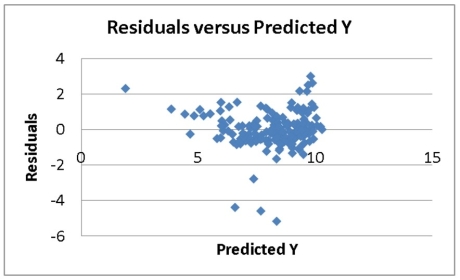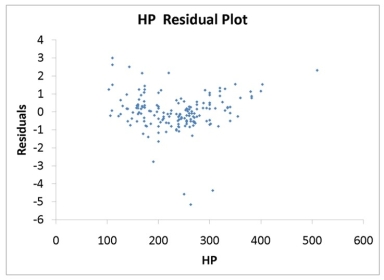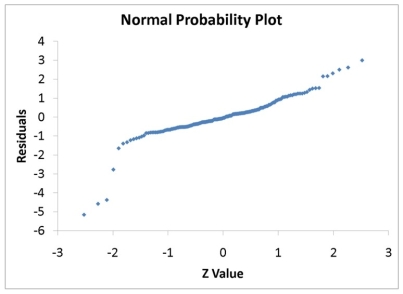TABLE 13-16
What are the factors that determine the acceleration time (in sec.) from 0 to 60 miles per hour of a car? Data on the following variables for 171 different vehicle models were collected:
Accel Time: Acceleration time in sec.
Cargo Vol: Cargo volume in cu. ft.
HP: Horsepower
MPG: Miles per gallon
SUV: 1 if the vehicle model is an SUV with Coupe as the base when SUV and Sedan are both 0
Sedan: 1 if the vehicle model is a sedan with Coupe as the base when SUV and Sedan are both 0
The regression results using acceleration time as the dependent variable and the remaining variables as the independent variables are presented below.

The various residual plots are as shown below.





The coefficient of multiple determination for the regression model using each of the 5 variables Xj as the dependent variable and all other X variables as independent variables (Rj2) are, respectively, 0.7461, 0.5676, 0.6764, 0.8582, 0.6632.
-Referring to Table 13-16, the error appears to be right-skewed.
Definitions:
Dizygotic Twins
also known as fraternal twins, are siblings that develop from two different eggs fertilized by two different sperm cells, sharing about 50% of their DNA.
Kinship Study
A research approach used to examine the genetic and environmental influences on traits, behaviors, and diseases by studying the similarities and differences among biological and non-biological relatives.
Kinship Studies
The scientific study of social relationships and structures based on blood relations, marriage, or adoption within human societies.
Monozygotic Twins
Twins that result from the division of a single fertilized egg, sharing all of their genetic material and typically having nearly identical appearances.
Q4: Companies promote profits,in part,by holding down employees'
Q8: _ refers to the design and implementation
Q15: Pertaining to CEO compensation,under classic economic theory,which
Q29: Without which type of skills is an
Q36: Referring to Table 11-8, the calculated test
Q44: Determining the root causes of why defects
Q44: Referring to Table 12-10, 93.98% of the
Q46: Referring to Table 14-8, an R chart
Q50: Referring to Table 11-13, the degrees of
Q52: Referring to Table 12-2, what is the